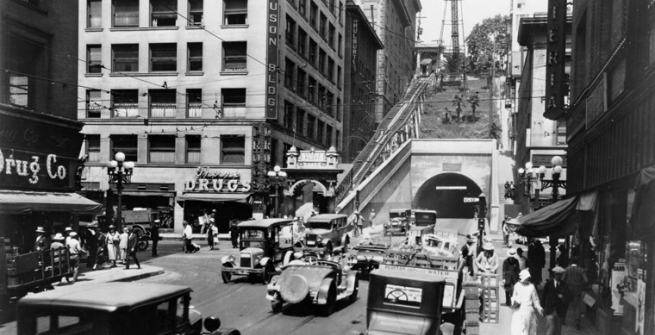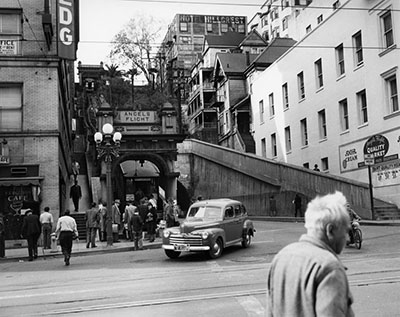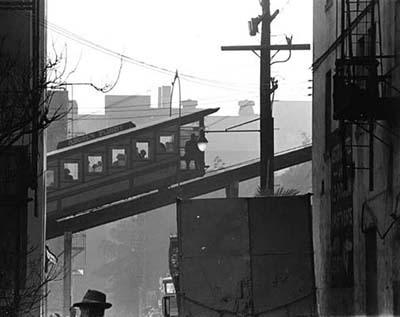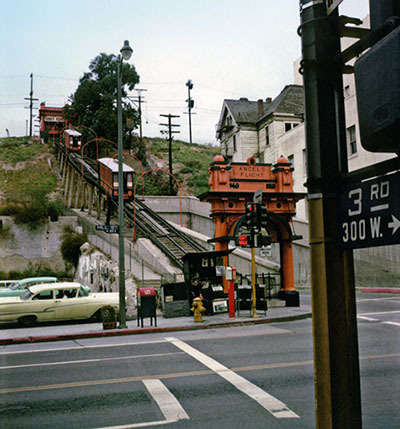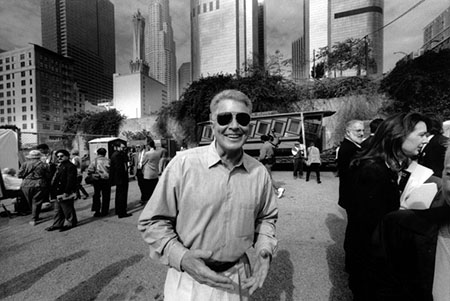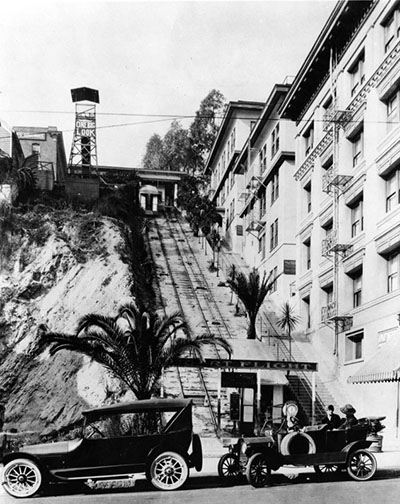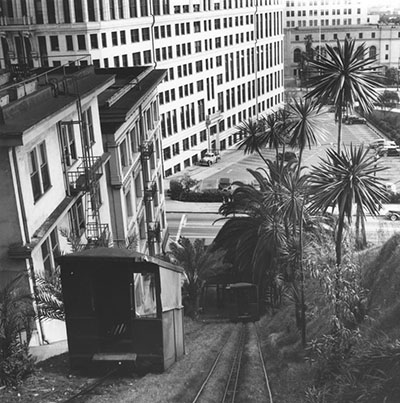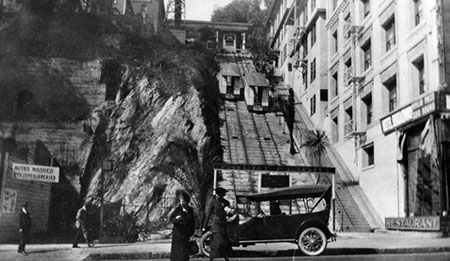A funicular railway or incline railway is a short railway located over a steep incline and operates by a cable wire and pulley system in which two tram-like cars on parallel rail tracks almost counter balance each other. As one car goes up, another goes down. This railway system became popular in the late 19 century and was used for commercial purposes and for public transportation. In the early 20th century there were over 200 funiculars operating throughout the United States. In its heyday Los Angeles had two funiculars in the Downtown area.
Angels Flight is the most well-known and longest-running funicular railway in Los Angeles. The original Angels Flight was located in Bunker Hill at Third Street between Hill and Olive and operated via a three-rail track with a passing section. Its two tram cars were named Olivet and Sinai. Col. James Ward Eddy financed the building of Angels Flight, and it debuted on December 31, 1901. Its official name was the Los Angeles Electric Incline Railway, but soon took on the nickname the World’s Shortest Railway since it was only 325 feet long. In 1905 Col. Eddy shut down the railway for a brief period to rebuild the tracks above Clay Street which shortened its length to 315 feet.
In 1910 Angels Flight received its iconic Beaux-Arts style archway and station house. Angels Flight was popularized on postcard images, and it quickly became a Los Angeles landmark. At first Angels Flight was a tourist destination but as the population of Downtown increased dramatically over the ensuing years, it became a vital mode of transportation for workers and residents in Bunker Hill. By the 1950s, changing fortunes Downtown and redevelopment pressures favoring the removal of Bunker Hill eventually led to the closure of Angels Flight in 1969.
Although there were some major efforts to reopen Angels Flight, most notably plans associated with the California Plaza project, it did not open again for another 27 years. The Community Redevelopment Agency was in charge of Angels Flight until 1995 when the Angels Flight Railway Foundation took over operations. In February 1996 Angels Flight reopened with great fanfare a half a block south of its original location. In 2001 a cable slipped and a car crashed killing one person and injuring others. Due to the tragic accident Angels Flight was again closed and not reopened until 2010. Safety problems continued to hamper operations throughout the decade, but additonal safety enhancements were finally made, and Angels Flight reopened for public service in 2017.
Many Los Angelenos today might be surprised to know that Downtown had a second incline railway called Court Flight from 1904-1943. Court Flight, a two-track parallel funicular, was built by Samuel G. Vandegrift and was located at 208 North Broadway next to the Hotel Broadway. On the eastern slope of Bunker Hill, it ran parallel to Court St. between Broadway and Hill (today this would be between what is now Temple and First St.) It was used primarily by Los Angeles County Courthouse and Hall of Records employees and residents in the Bunker Hill/Court Hill area. It also featured an adjacent stairway and a parking lot at the top of the hill. At the top of the incline was an observation tower with a sign that said “One Big Look.”
Samuel Vandegrift was in charge of operations until his death in 1932, when his widow Annie took over. In September 1942 Mrs. Vandegrift petitioned the Board of Public utilities to cease the railway’s operations due to low ridership and difficulty finding operators because of labor shortages from World War II. On January 26, 1943, the California Railway Commission granted Mrs. Vandegrift a permit to abandon the railway. A fire burned the abandoned tracks in October 1943. Although Court Flight never became quite as iconic or touristy as the nearby Angeles Flight, it had its place as a part of the Old Los Angeles that has vanished.
All images are from the Los Angeles Public Library Photo Collection.
